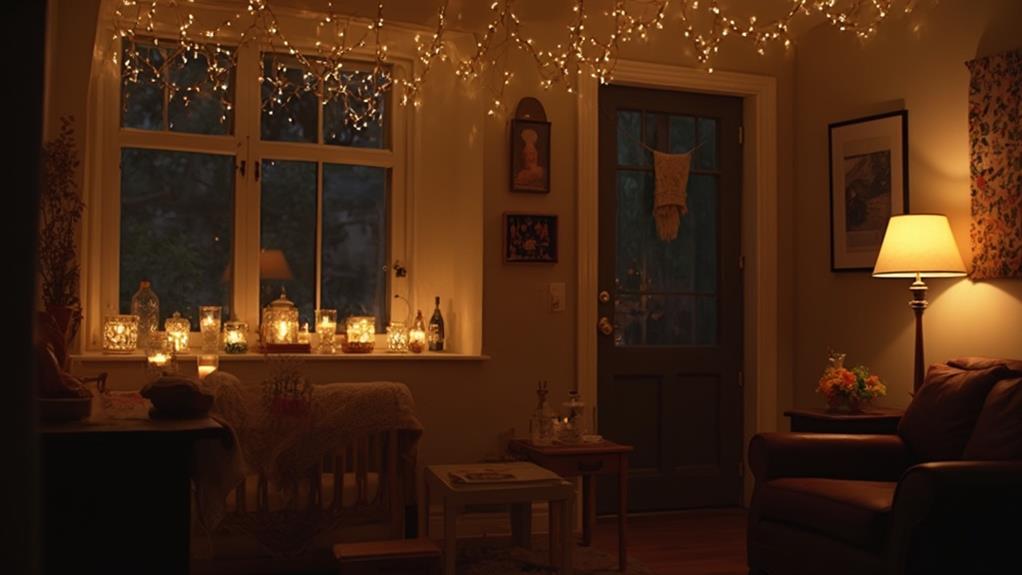Low-cost lighting ideas can transform your home's ambiance without straining your budget. DIY projects like mason jar pendant lights or repurposed wine bottle lamps offer creative, affordable solutions. Strategically placing lamps in corners and on end tables enhances room functionality. Maximizing natural light by keeping windows unobstructed and using mirrors reduces reliance on artificial lighting. Budget-friendly fixtures can be found at discount stores or through online marketplaces. Reflective surfaces, such as metallic accents and glossy finishes, amplify existing light. Smart bulbs and automation provide energy-efficient options for customizable lighting. By exploring these innovative approaches, you'll discover numerous ways to illuminate your space beautifully and economically.
DIY Lighting Projects
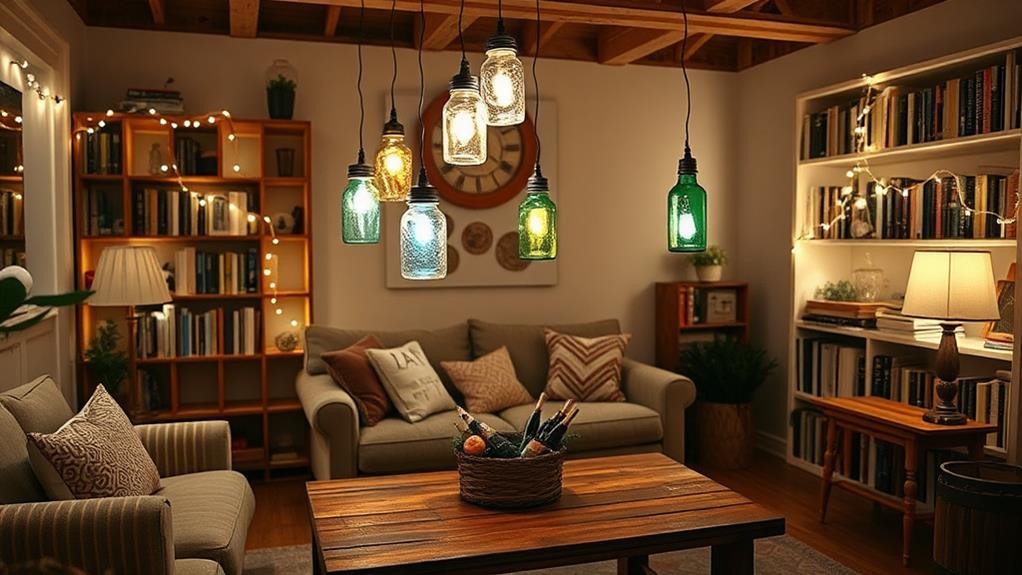
While many homeowners believe custom lighting solutions are expensive, DIY lighting projects offer an affordable and creative alternative. These projects allow you to transform everyday objects into unique lighting fixtures, adding personality to your space without breaking the bank.
One popular DIY option is the mason jar pendant light. By drilling a hole in the jar lid and threading an electrical cord through it, you can create a charming, rustic fixture. Another idea is to repurpose old wine bottles into table lamps using lamp kits available at hardware stores.
For a more modern look, consider creating geometric pendant lights using wooden dowels and LED strips. Alternatively, construct a minimalist floor lamp using copper pipes and fittings for an industrial chic aesthetic.
Upcycling is another cost-effective approach. Transform old colanders, baskets, or even musical instruments into eye-catching light fixtures. With some creativity and basic wiring knowledge, these items can become conversation pieces in your home.
Remember to prioritize safety when working with electrical components. If you're unsure about wiring, consult a professional or opt for battery-operated LED lights to eliminate electrical hazards in your DIY projects.
Strategic Lamp Placement
Strategic lamp placement can dramatically enhance a room's ambiance and functionality without requiring significant investment. By carefully positioning lamps throughout your space, you can create layers of light that serve different purposes and highlight key areas.
In living rooms, place table lamps on end tables flanking the sofa to provide balanced, soft lighting for reading or conversation. A floor lamp in a corner can add depth and eliminate shadows.
For dining areas, consider hanging a pendant light or chandelier centered above the table, complemented by buffet lamps on nearby sideboards.
In bedrooms, place matching bedside lamps on nightstands for symmetry and practicality. A desk lamp in a home office should be positioned to minimize glare on computer screens. In kitchens, under-cabinet lighting can improve task visibility while creating a warm glow.
Use wall sconces in hallways or bathrooms to save floor space and provide even illumination. When arranging lamps, consider the room's natural light sources and adjust placement accordingly. By strategically distributing light sources, you can create a well-lit, inviting atmosphere that enhances your home's overall appeal and functionality.
Natural Light Maximization
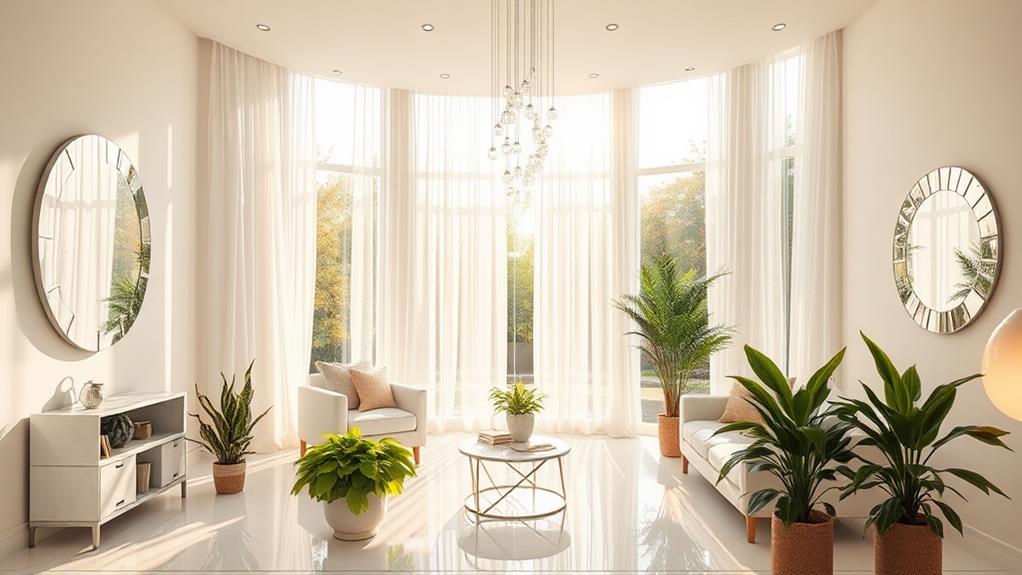
Sunlight, nature's free illumination source, can significantly reduce your reliance on artificial lighting and energy costs. To maximize natural light in your home, start by keeping windows clean and unobstructed. Remove heavy curtains or blinds and opt for sheer or light-filtering window treatments that allow sunlight to pass through while maintaining privacy.
Strategic mirror placement can amplify natural light by reflecting it into darker areas of a room. Position large mirrors opposite windows to bounce light deeper into the space. Consider using reflective surfaces like glossy paint or metallic accents to further enhance light distribution.
Trim any outdoor foliage that may be blocking sunlight from entering your windows. If privacy isn't a concern, remove window screens during daylight hours to allow more light in. For rooms with limited natural light, consider installing solar tubes or skylights to bring in additional daylight from above.
Light-colored walls and ceilings can also help maximize natural light by reflecting it throughout the room. Choose pale, neutral tones for a brighter, more open feel. Lastly, arrange furniture to allow for unobstructed light flow, keeping taller pieces away from windows.
Budget-Friendly Fixture Shopping
When it comes to artificial lighting, finding affordable fixtures is key to maintaining a low-cost lighting strategy. Start by exploring discount home improvement stores, thrift shops, and online marketplaces for budget-friendly options. Look for sales, clearance items, and seasonal promotions to maximize savings. Consider purchasing floor lamps, table lamps, and pendant lights in bulk if you need multiple fixtures for different rooms.
DIY lighting projects can significantly reduce costs while adding a personal touch to your decor. Repurpose everyday objects like mason jars, wine bottles, or industrial pipes to create unique light fixtures. For a modern look, opt for simple, minimalist designs that are often less expensive than ornate options.
Energy-efficient LED bulbs may have a higher upfront cost but offer long-term savings on electricity bills. When shopping for fixtures, ensure they are compatible with LED bulbs to maximize energy efficiency. Consider smart lighting systems that allow for customization and energy management, potentially leading to additional savings over time. Lastly, don't overlook the potential of string lights or battery-operated LED lights for accent lighting, as they can provide ambiance at a fraction of the cost of traditional fixtures.
Reflective Surfaces for Brightness
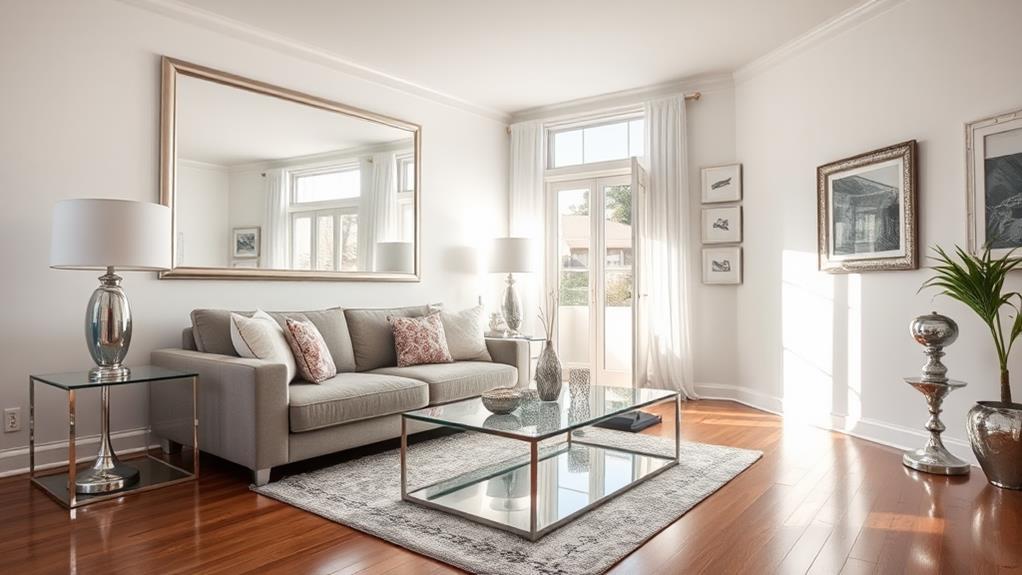
Leveraging reflective surfaces is an effective way to enhance brightness without increasing energy consumption or costs. Strategic placement of mirrors, metallic accents, and glossy finishes can significantly amplify existing light sources, creating a brighter and more spacious atmosphere.
Large mirrors positioned opposite windows maximize natural light by reflecting it throughout the room. Similarly, mirrored furniture or decorative pieces can scatter light in various directions. For a budget-friendly option, consider using metallic picture frames or wall art to add reflective elements.
Light-colored, glossy paint on walls and ceilings can also improve light reflection. Opt for semi-gloss or high-gloss finishes in white or pale hues to bounce light effectively. In the kitchen, installing a backsplash with reflective tiles or a mirrored surface behind the stove can brighten the space considerably.
Don't overlook the potential of reflective accessories. Chrome or stainless steel light fixtures, polished metal vases, or glass tabletops can all contribute to a brighter environment. Even small touches like metallic throw pillows or shiny picture frames can make a noticeable difference in overall room brightness.
Smart Bulbs and Automation
Smart bulbs and automation systems represent a technological revolution in home lighting, offering both convenience and energy efficiency. These devices allow users to control their lights remotely via smartphone apps or voice commands, enabling precise adjustments to brightness, color, and timing. While the initial investment may be higher than traditional bulbs, smart lighting can lead to significant energy savings over time.
Many smart bulbs use LED technology, which consumes less power and lasts longer than incandescent or CFL alternatives. Users can easily schedule lights to turn on and off automatically, reducing wasted energy when rooms are unoccupied. Some systems even integrate with motion sensors or geofencing technology to activate lights only when needed.
Color-changing smart bulbs offer versatility in creating ambiance for different occasions or times of day. Warm tones in the evening can promote relaxation, while cooler tones during work hours may enhance productivity. Additionally, smart lighting systems can be integrated with other home automation devices, such as thermostats and security systems, for a comprehensive smart home experience. As prices continue to decrease, smart bulbs and automation are becoming increasingly accessible options for budget-conscious homeowners seeking to modernize their lighting solutions.
Repurposing Everyday Objects
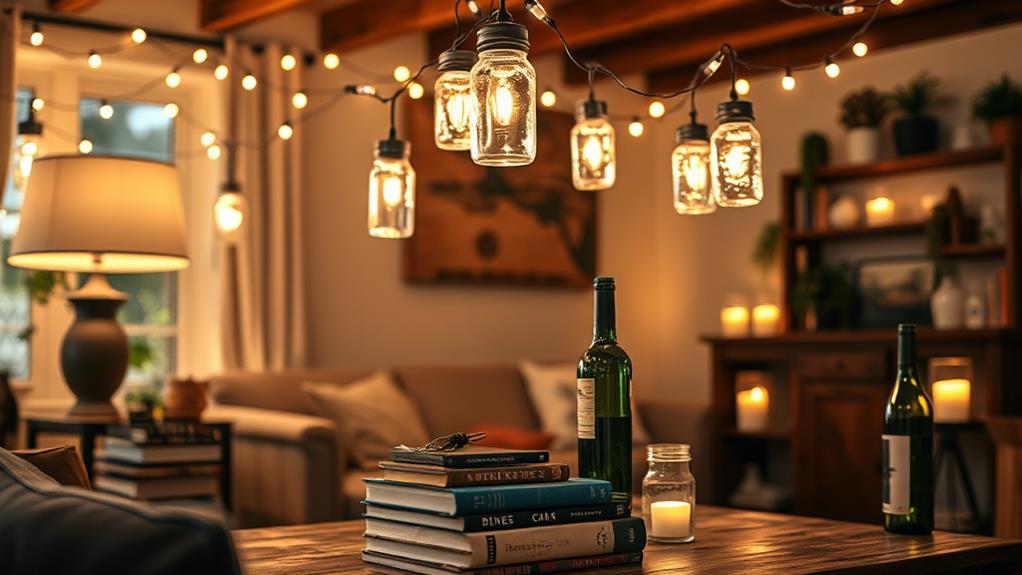
Creative repurposing of everyday objects offers an eco-friendly and cost-effective approach to home lighting. By transforming common household items into unique light fixtures, homeowners can add character to their spaces while minimizing expenses and reducing waste.
Mason jars, for instance, can be easily converted into charming pendant lights or table lamps. Simply drill a hole in the lid for the cord, insert a light socket, and hang or place as desired. Wine bottles can be repurposed into elegant floor lamps by threading a lamp kit through the bottle's neck. Colanders and wire baskets make for interesting ceiling fixtures when inverted and fitted with bulbs.
Old books can be hollowed out to create bedside lamps, while vintage teapots or coffee pots can be transformed into quirky table lamps. Branches, driftwood, or reclaimed wood can be fashioned into rustic wall sconces or floor lamps. Even ordinary tin cans, when cleaned and painted, can become attractive accent lights when punched with decorative patterns.
These DIY lighting projects not only save money but also allow for personalization and creativity in home decor. With some imagination and basic tools, everyday objects can be given new life as functional and stylish light sources.
Frequently Asked Questions
How Can I Safely Install New Lighting Fixtures Without Hiring an Electrician?
When installing new lighting fixtures, prioritize safety. Turn off power at the circuit breaker, use a voltage tester, and follow manufacturer instructions carefully. For complex installations or if unsure, it's best to consult a licensed electrician.
What Are the Best Lighting Options for Homes With Low Ceilings?
Contrary to the belief that low ceilings limit options, there are numerous elegant solutions. For homes with low ceilings, recessed lighting, flush-mount fixtures, and track lighting are excellent choices. These options provide ample illumination without protruding into living space.
How Do I Choose the Right Color Temperature for Different Rooms?
Consider the room's purpose when selecting color temperature. Use warmer tones (2700-3000K) for relaxing spaces like bedrooms and living rooms. Opt for cooler temperatures (3500-4000K) in task-oriented areas such as kitchens and home offices.
Are There Energy-Efficient Lighting Solutions That Don't Compromise on Brightness?
Yes, energy-efficient lighting solutions that maintain brightness are available. LED bulbs offer excellent luminosity while consuming less energy. Additionally, smart lighting systems allow for customizable brightness levels and automated controls, further optimizing energy usage without sacrificing illumination quality.
What Lighting Techniques Can Make a Small Room Appear Larger?
To make a small room appear larger, employ strategic lighting techniques such as:
- Use multiple light sources
- Install recessed lighting
- Incorporate vertical lighting
- Utilize wall sconces
- Add mirrors to reflect light
- Opt for uplighting
Conclusion
As the warm glow of creativity illuminates homes, budget-conscious lighting solutions emerge like beacons of ingenuity. From repurposed mason jars casting intricate shadows to strategically placed mirrors amplifying natural sunlight, these ideas transform living spaces into radiant sanctuaries. Smart bulbs dance in harmony with daily routines, while thrifted fixtures add character to once-dim corners. With each thoughtful adjustment, rooms come alive, bathed in a soft, inviting luminescence that nurtures both body and spirit, proving that brightness need not come at a high cost.
